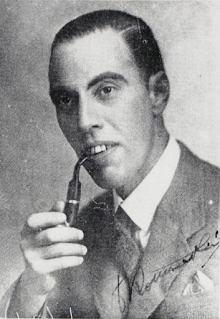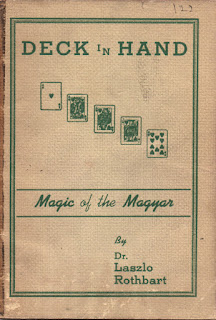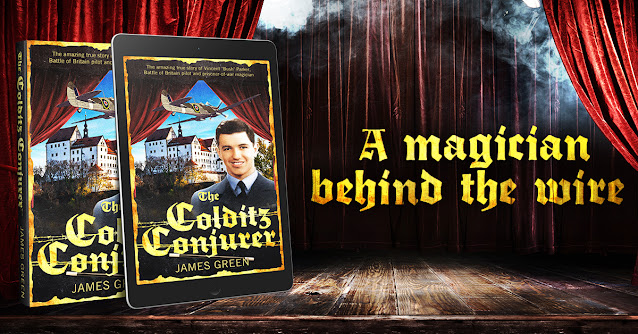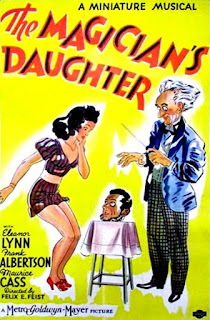Hungary has a proud history of magic. Famously, Harry Houdini (Erich Weisz) and his younger brother Hardeen (Ferencz Dezso Weisz) were born there. When magician Charles H. Larson visited the country in 1938, he wrote, "Magic and Budapest compares with the best I have seen...Magicians here are [the] highest type professionals and business men. Magic should be proud of such dignity." One of these professionals was Dr. Laszlo Rothbart. Born in Budapest in 1897, he was an educated man with good language skills. Rothbart's main occupation was a Doctor of Medicine. He led a successful career, and by his late thirties, was Chief of Hospital Staff, owning a three-story town-house hospital and x-ray laboratory in the capital city.
Rothbart was a member of the Magyar Amateur Magusok Egyesulete (M.A.M.E.) (translates as Hungarian Amateur Magicians Association), the leading magic club for amateurs in Hungary between the world wars. In the late 1920s and early 1930s, he served on M.A.M.E.'s board and as its treasurer. He was also a founder member of the Magyar Mukedvelo Buveszek Kore (M.M.B.E.) (translates as Circle of Hungarian Amateur Magicians) formed in 1938, serving by turn as its secretary and president.
Dr. Laszlo Rothbart
(Source: Linking Ring, Vol. 27, No. 11)
In the years leading up to World War Two, Rothbart created scores of original magic effects, or variations of existing plots. These were published in popular magic periodicals, such as Bat, Chap's Scrapbook, Genii, Jinx and Linking Ring in America, George Johnson's The Magic Wand in the U.K., Hokus Pocus (the Journal of The Magic Ring of Switzerland), La Baguette Magique (translates from French as The Magic Wand), Magi (translates from Danish as Magic), and Magikeren (translates from Norwegian as Magician). He also edited and contributed to M.M.B.E.'s in-house journal, Házi Közlönye, which ran for around 60 issues from 1938 to 1942. Few other magicians have contributed magic to such a range of magazines. Most of Rothbart's magic was in the ever-popular domain of card tricks, often with a mental magic theme. He also developed tricks or moves with sponge balls, rubber bands, thimbles, matches and other small objects.
Cover image for Házi Közlönye, the in-house magic magazine of
the Circle of Hungarian Amateur Magicians, edited by Dr. Rothbart
(Source: M.M.B.E., courtesy of Swedish Magic Circle Library)
A rather unflattering 1926 sketch of Laszlo Rothbart from a book about Hungarian magicians
(Source: Magyar Magia by Kelle Botand, courtesy of Erik Nordvall)
Rothbart wrote up 25 of his best card tricks in an English-language book called 'Deck In Hand: Magic of the Magyar' (or, fully translated, 'Magic of the Hungarian'). It was published, in early 1941, by Abbott's Magic Novelty Co., based in Colon, Michigan in the U.S.A. The introduction to this 48-page book was written by American magician, Caryl S. Fleming, an advocate for international collaboration and a leading voice in the creation of the International Alliance of Magicians. In the introduction, Rothbart's long-distance friend wrote about the kinship between magicians:
"This work represents more than just that which appears between its covers. It is the product of the peculiar bonds of friendship which instinctively develop through correspondence between two distantly separated individuals with a common interest - MAGIC - which speaks an universal language, appreciated and understood by all within its ever-widening circle, despite the possible complete ignorance of its Babel of tongues."
'Deck in Hand: Magic of the Magyar' (1941) by Dr. Laszlo Rothbart
(Source: Author's collection)
The book was well received by the magic community, containing tricks that appealed to lay audiences rather than just magicians, and novel advancements in technique and methods. Fleming described Rothbart was "an outstanding magician" with "an highly constructive mental capacity for invention, adaptation and presentation". "He is the most prolific inventor of brilliant effects in card magic now used the world over," wrote John Mulholland in The Sphinx.
Rothbart was a social magician and enjoyed sharing his magic and learning from others. For years, he regularly and prolifically corresponded with other magicians and magic clubs all over Europe and America, where he built-up strong relationships. He was the de facto foreign correspondent for the Hungarian magic scene.
He continued creating and submitting tricks for publication throughout the war, and sending occasional updates on club news, such as theatre shows put on by magicians in Hungary. But, censorship and the banning of communication with 'the enemy', reduced letters to and from Rothbart, especially after the U.S.A. joined the war in December 1941. From 1942 to 1944, Rothbart's tricks appeared in neutral Switzerland's Hokus Pocus magazine, presumably because it was one of the few countries outside of the Axis Powers he could still write to.
Then, in 1944, Rothbart's contributions stopped and he vanished.
Laszlo Rothbart (top right) at a meeting with German magician Kalanag (Helmet Schreiber) (centre, seated) in Budapest, Hungary
(Source: Erik Nordvall)
In October 1945, Percy Abbott's The Tops magazine carried a report from Europe by magician Jack Stanley (Jaks), that Dr. Rothbart was assumed to have been killed. The same month, The Sphinx magazine conjectured that Rothbart was murdered by the Nazis; noting that news had reached America that another Hungarian magician and physician, Dr. Vilmos Lenard, had been murdered three days before the Russians captured Budapest from the Germans.
In fact, Laszlo Rothbart survived the war, but only just.
Rothbart was Jewish. When Hungary's leaders chose to align themselves with the governments of Nazi Germany and Fascist Italy, they adopted a series of anti-Jewish measures. Starting in 1938, these included restricting the number of Jews in certain occupations (including medicine), banning intermarriage between Jews and non-Jews, and prohibiting their employment in government jobs at any level. Life for Rothbart and the Jewish population of Hungary became incredibly difficult. His situation became worse when his hospital was destroyed by a bomb, probably from an Allied air attack.
There were several massacres of Hungarian Jews and over 40,000 were called up to serve in unarmed 'labour service' units on the Eastern Front. But, for most of the war, the Hungarian government resisted German pressure to allow the deportation of Hungarian Jews to the German extermination camps in occupied Poland. This anomalous situation lasted until March, 1944, when German troops occupied Hungary.
In April 1944, the Germans decided to deport all of Hungary’s Jews. Yellow Star and Ghettoization laws were introduced and the deportations started in May. On a typical day, three or four trains, each with 45 cattle cars, transported 12,000 Jews from Hungary to extermination camps. Some days, 10 or more trains were despatched. By July, 440,000 Jews had been deported. Almost all of the deportees went to Auschwitz, where they were murdered on arrival. It is estimated one third of all the murdered victims at Auschwitz were Hungarian. Eventually, international pressure - bolstered by the D-Day landings and liberation of Rome in June 1944 - persuaded the Hungarian government to halt the deportations.
We know that Rothbart ended up in a "concentration camp". It is probable this was Auschwitz, given that 99.7% of deported Hungarian Jews ended up there. If he did get sent to Auschwitz, Rothbart was one of the lucky ones not to be killed on arrival. As a fit, healthy, middle-aged male, he may have been selected, probably at random, to be part of the Auschwitz labour force, processing arriving deportees, digging burial pits, and other such menial and gruesome duties. An alternative theory is that Rothbart was imprisoned in one of the government-controlled Jewish ghettos in Budapest.
As a prisoner, Rothbart would likely have helped his fellow inmates, treating injuries and disease using his medical skills, and possibly bringing fleeting moments of pyschological relief through his magic skills. Rothbart's passion for magic may also have helped his own mental condition, allowing him to escape his physical bonds by distracting his thoughts towards creating, performing and sharing magic.
Prisoners at Auschwitz concentration camp
(Source: Public domain)
Eventually, after six months in captivity, malnourished, ill and scarred by the experience, Dr. Laszlo Rothbart was freed by advancing Soviet troops. They arrived at Auschwitz in January 1945, liberating the Budapest ghettos the same month.
News of Rothbart's survival came from Jack Stanley, in a report in the Linking Ring in June 1946. "He is now in a sanatorium [in Budapest] very sick, having contracted tuberculosis". The doctor had become the patient.
Aside from his serious illness, Rothbart's other main problem was getting hold of food. It was in short supply and he had no money to pay for it. Stanley started sending Rothbart food parcels and called on members of the International Brotherhood of Magicians to do the same; which they did. Echoing Fleming's introduction to 'Deck In Hand', the kinship of magicians and their common bond of magic, overrode the fact that Rothbart was a native of an enemy country.
In October 1946, the Linking Ring published a further update on Rothbart's condition, saying that he was now so poor he even had difficulty securing paper to write his letter for help and had to borrow money to send it.
In better news, American Dr. Zina B. Bennett, a fellow magician and physician/surgeon - and a long-term pen pal with Rothbart - received a letter from him in July 1947, informing that he was now back home, having being discharged from hospital. Seemingly, two years after the war ended, Rothbart could begin rebuilding his life.
But, just after Christmas 1948, a letter from Bennett to Rothbart was returned unopened with a note scribbled on the envelope by the postal service. Other writers received the same annotations.
Devastated by the war, diagnosed with incurable tuberculosis and facing an imminent painful death, Dr. Laszlo Rothbart had taken his own life on 8 August, 1947, aged 50 years old.
Any more information on Laszlo Rothbart would be greatly appreciated. Given his extensive letter writing, some of his original letters no doubt exist in magic collections around the world. Post comments below, or get in touch via the Contact Form, and I can update the blog.
Related article: 'Dutch magician deported to extermination camp', tells the wartime story of card magician Louis Lam. Blog link.
*** AVAILABLE NOW ***
The Colditz Conjurer tells the amazing true story of Flight Lieutenant Vincent ‘Bush’ Parker, Battle of Britain pilot and prisoner-of-war magician.
Written by the Magic at War team, The Colditz Conjurer is a remarkable tale of perseverance, courage and cunning in the face of adversity. It features over 55 original photographs and maps. 126 pages.














Comments
Post a Comment